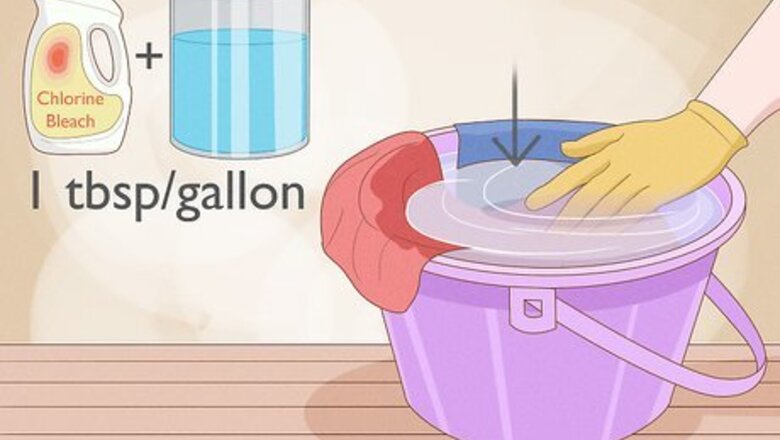
views
- Place the dried gourds in a container of lukewarm water and cover them with wet towels. Let them soak for 15-30 minutes.
- Then, scrub the gourds with a metal dish scrubber or scouring pad. Rinse them with water and then let them air dry for 1 to 2 days.
- To clean the inside of the gourd, cut it open with a hand saw or jig saw. Remove the pulp and seeds with your hands and clean out the sides with a spoon or scraper.
Cleaning the Outside of Dried Gourds
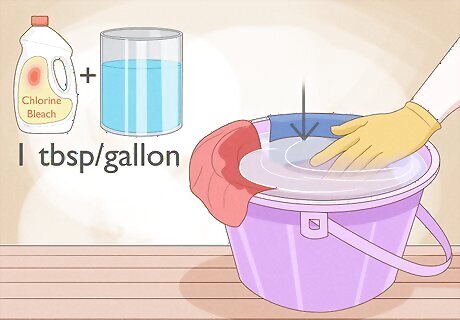
Fill a large container with lukewarm water and wet several clean rags. Find a container or tub large enough to hold your gourds and fill it with lukewarm water. Then, grab several clean towels and submerge them in the water until they’re dripping wet. Do not use hot water, as this can cause the gourd to crack. For extra cleaning power, add 1 tbsp (15 ml) of bleach per gallon (3.8 l) of water in the container. The bleach helps kill mold and bacteria on the gourd. If you don’t want to use bleach, add a squirt of liquid dish soap. This can also help clean and disinfect the outside of the gourd.
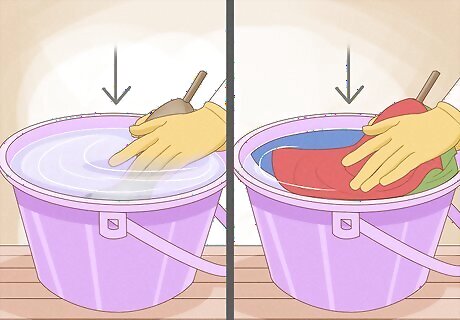
Put the gourds in the container and cover them with towels. Place the gourds inside the tub of water so at least one side of each gourd is submerged. Dried gourds float, so cover the sides of the gourds that aren’t in the water with the wet towels. Place a dumbbell, brick, or other weighted object on top of the towels to help keep the gourds submerged in the water.

Let the gourds soak in the water for 15 to 30 minutes. Leaving the gourds in the water helps soften the dried skin and loosen any mold, dirt, and other debris. Just let the gourds soak for about 15 to 30 minutes. To help soften the gourds’ skin further, turn the gourds over about halfway through the soaking process so the other side is submerged in the water.

Put on gloves and a respirator mask and move to a well-ventilated area. Cleaning your gourds can expose you to mold, dirt, and bacteria, so make sure to wear cleaning gloves and a respirator mask. Then, work outside or move to a well-ventilated room in your house where you can open the windows or turn on a fan.
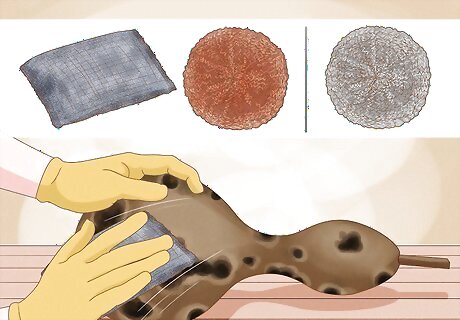
Scrub the gourds with a metal dish scrubber or scouring sponge. Hold the gourd in the water and use an abrasive scrubber or sponge to remove the dried skin and layers of mold and dirt. Just press hard enough to scrub away the debris but not so hard that you scratch the gourd. It usually takes some elbow grease and a few minutes of scrubbing to completely clean the gourd. Don’t forget to scrub the stem, too! It's normal for some of the mold and dirt to stain the gourd. You can sand away these spots when the gourd is fully dry, which we explain below. Avoid using steel wool to clean your gourds, as it tends to leave metal particles on the gourd.
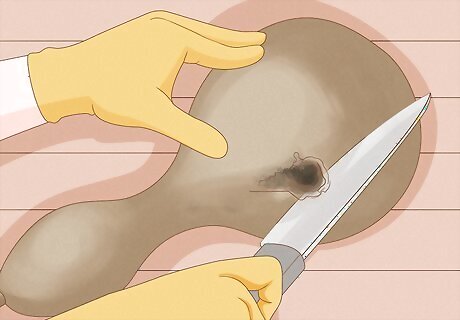
Scrape off stubborn pieces of skin and mold with a butter knife. If your scrubbing pad isn’t removing stuck-on pieces of skin and debris, grab a butter knife or scraper. Carefully scrape your tool against the spots on your gourd to prevent scratching or cutting into it. If the spots still aren’t coming off, let the gourd soak in the water again for about 30 minutes. Then, scrub and scrape off the debris.

Rinse off the gourds and let them air dry away from sunlight and heat. Hold your gourds under cool, running water to wash away the skin and debris you removed, as well as any cleaning agents you used. Then, set the gourds on a wire rack and place them in a cool, dry, and well-ventilated spot to air dry for 1 to 2 days. When your gourds are fully dry, they’re ready to be displayed as decor or used in fun arts and crafts projects, like painting them or making a gourd birdhouse! Keep the gourds out of direct light and away from heat sources, as this can cause the gourd to crack.

Sand off any leftover skin or stained spots on the gourds. Sanding your gourds is optional if you want an extra smooth finish or to get rid of any unsightly spots. Just start sanding with 80-grit sandpaper. Then, work your way up to fine, 120-grit sandpaper. Feel free to use just the sandpaper or a sanding block or sander.
Cleaning the Inside of Dried Gourds

Put on gloves, a respirator mask, and safety goggles. Cutting into your gourd and cleaning the inside can expose you to mold and dust, so it’s important to protect yourself. Wear gloves, a respirator mask, and goggles and work outside or in a well-ventilated area. You do not have to clean out the inside of your gourd if you’re just using it as decoration or painting the outside.
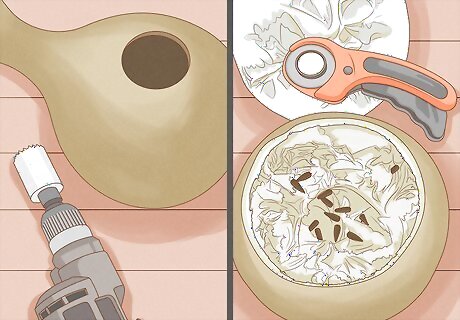
Cut the gourd open with a hand saw, jig saw, or power drill. How and where you cut your gourd depends on what you plan on using it for. For instance, if you’re using the gourd as a vase, you might simply cut off the top with a hand saw. If you’re cutting out a more intricate design, you might use a jig saw instead. Outline where you want to cut the gourd using a pencil. As another example, you might use a power drill to make a simple opening for a birdhouse.

Clean out the inside of the gourd with your hands and scraping tools. Reach inside the gourd with your hands and pull out the dried pulp and seeds. Then, grab a gourd scraping tool, spoon, or clay sculpting tool and drag it against the sides and bottom of the gourd. This gets rid of dried pulp and skin you couldn’t remove with your hands and smooths the interior of the gourd. Shake the gourd over a trash can or trash bag to get all of the debris out. Note: If you’re making a birdhouse, you don’t have to scrape out the inside. Birds don’t mind the debris and often use it to build their nests. If the opening is too small or the pulp and seeds are in a tough ball, soak the gourd in warm water for 30 minutes to loosen the debris. After cleaning the inside, let the gourd completely air dry. Save the pulp and seeds for fun projects, like planting gourds or creating pulp sculptures.
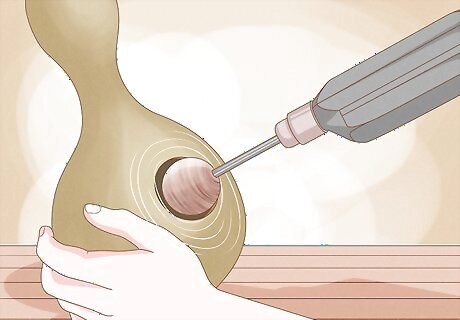
Sand the inside of the gourd. If you’re making a bowl or your project needs a super smooth inside, sand down the gourd to an even finish. Just use sandpaper, a mushroom tool, or add a gourd ball cleaner attachment onto a power drill. Then, buff the inside of the gourd until it’s at your liking. When you’re done sanding the inside of the gourd, feel free to add primer, dye, or paint to decorate the gourd.
Drying Fresh Gourds
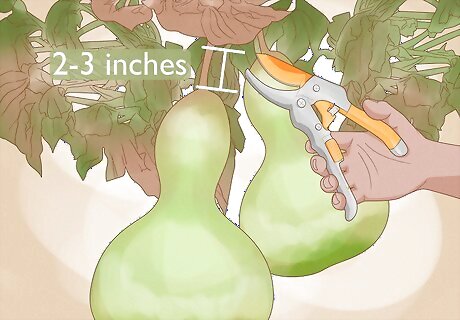
Cut gourds from the vine when the stem turns brown and dries out. If you’re growing your own gourds, wait to harvest them until the stem is dry and looks brown. Just use clean cutting shears to snip the gourd from the vine, leaving 2 to 3 inches (5-7.6 cm) of stem on the fruit.
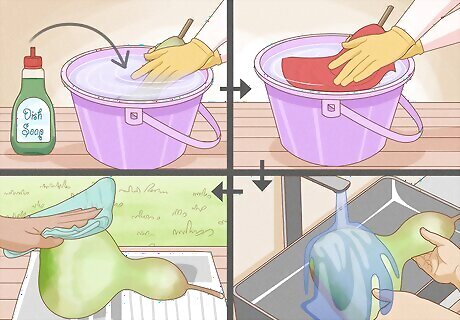
Wash the gourds with warm water and soap, and then dry them. Fill your sink or a bucket with warm water and pour in several drops of hand soap or dish soap. Then, add in the gourds and use a soft cloth to wipe them clean. Rinse the gourds off with water and use a clean towel to dry them off.

Place the gourds on sheets of newspaper in a warm, dry spot. Spread out several sheets of newspaper in a well-ventilated area that stays warm and dry, like your garage or a shed. Then, lay the gourds on the paper so they aren’t touching one another.
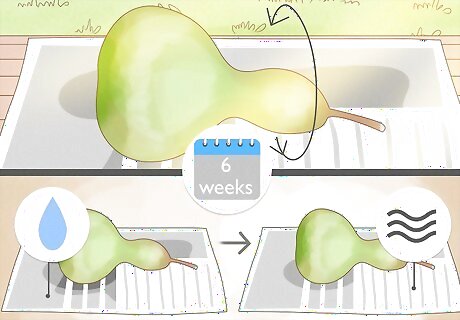
Dry the gourds for 6 weeks, turning them and changing the paper often. It can take several weeks for the gourds to fully dry out. Every few days, rotate the gourds so each side gets air and dries evenly. Then, check the newspaper. If it feels damp, replace it with fresh sheets. Your gourds are fully dry when they feel light and you can hear the seeds rattling around inside. It might take your gourd more or less than 6 weeks to dry. Different gourds have different drying times, with some taking 1 month and others taking 6 months. It’s normal for some gourds to rot during the drying process, so don’t feel discouraged if yours do. Just remove any gourds that shrivel up or grow soft.



















Comments
0 comment